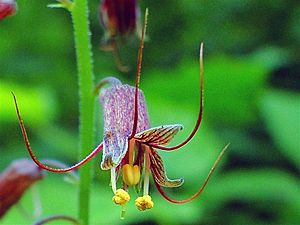Tolmiea menziesii facts for kids
Quick facts for kids Tolmiea menziesii |
|
|---|---|
 |
|
| Scientific classification | |
| Genus: |
Tolmiea
|
| Species: |
menziesii
|
The Tolmiea menziesii plant is also known by fun names like youth on age, pick-a-back-plant, piggyback plant, and thousand mothers. It's a type of plant that lives for many years. You can find it growing naturally along the West Coast of North America. This includes places like northern California, Oregon, Washington, British Columbia, and southern Alaska. It also grows in some parts of Scotland, Wales, Northern Ireland, and England, often after escaping from gardens.
Contents
What the Plant Looks Like
The Tolmiea menziesii has leaves that are covered in tiny hairs. Each leaf has five to seven lobes, which means it has rounded sections. The edges of the leaves are also toothed, like a saw.
This plant grows many small flowers. They appear on a loose stem, almost like a bunch. Each flower has a tube-shaped part that is purple-green or brown-green. It also has four thin, red-brown petals. These petals are about twice as long as the tube part.
How the Plant Reproduces
This plant has some very interesting ways to make new plants! It can grow tiny new plantlets right on its leaves. These plantlets grow near the base of each leaf, on a stalk called a petiole. When these little plantlets get big enough, they drop off the main leaf. They then fall onto the soil and start to grow roots, becoming new plants. This is why it's called "youth on age" or "piggyback plant."
Besides these leaf plantlets, the Tolmiea menziesii can also spread in other ways. It can grow new plants from underground stems called rhizomes. It also produces seeds, which can grow into new plants too.
Naming the Plant
The name of the plant, Tolmiea, comes from a Scottish-Canadian botanist named William Fraser Tolmie. A botanist is a scientist who studies plants. The second part of its name, menziesii, honors Archibald Menzies. He was a Scottish naturalist who explored during the Vancouver Expedition (1791–1795).
For a long time, scientists thought this plant was the only one of its kind in the Tolmiea group. But now, they have found another very similar plant. It is called T. diplomenziesii.
Growing the Plant
The Tolmiea menziesii is a popular plant to grow in gardens and homes. People often grow it as an ornamental plant, which means it's grown for its beauty. It makes a great houseplant because it's interesting to look at. It can also be planted outside as a groundcover, which is a plant that spreads out low to the ground.
If you want to grow this plant, it needs plenty of moisture. It does not like too much direct sunlight or very dry conditions.
Images for kids
See also
 In Spanish: Tolmiea menziesii para niños
In Spanish: Tolmiea menziesii para niños



